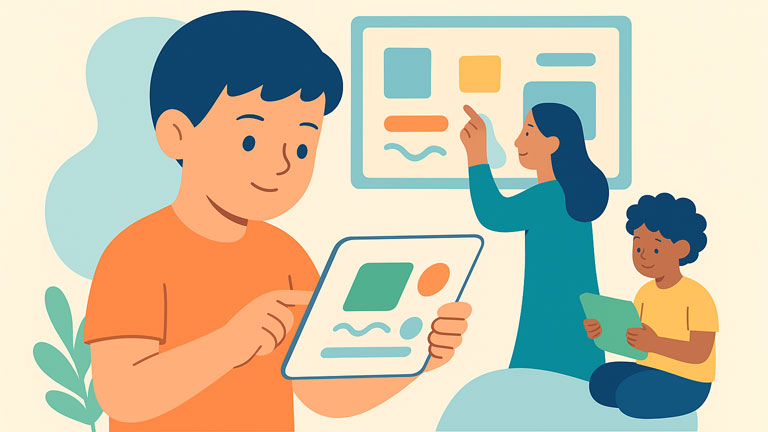WebRTC (Web Real-Time Communication) has transformed the way we communicate online. Initially known for enabling real-time video and audio communication, WebRTC has evolved to offer a wide array of advanced features that extend beyond mere video calls. In this comprehensive guide, we will delve into these advanced features and explore how they can be leveraged to create innovative applications. Additionally, we will discuss the importance of hiring the right WebRTC application development company and services, as well as how to hire WebRTC developers for your project.
WebRTC: A Brief Overview
Before we delve into advanced features, let’s have a quick recap of what WebRTC is. WebRTC is an open-source project that allows real-time communication directly in web browsers and mobile applications without the need for plugins or third-party software. It leverages a set of APIs and protocols to enable peer-to-peer communication, making it ideal for applications that require low latency, secure, and reliable communication.
Advanced Features in WebRTC Application Development
1) Data Channels
While WebRTC is widely associated with video and audio communication, Data Channels, which enable the exchange of arbitrary data between peers, are also included. Various purposes, such as real-time file sharing, collaborative document editing, or even multiplayer gaming, can be served by Data Channels. This feature opens up new possibilities for interactive and data-driven applications.
2) Screen Sharing
Screen sharing is a valuable feature in WebRTC application development. It allows users to share their screens with others during video calls or conferences. This feature finds applications in remote work collaboration, tech support, and online education, among others.
3) Recording and Playback
WebRTC now offers built-in capabilities for recording audio and video streams during communication sessions. These recordings can be stored, played back, or shared later. This feature is particularly useful in scenarios where you need to archive important meetings, interviews, or presentations.
4) Real-Time Text Messaging
Incorporating real-time text messaging within a WebRTC application can enhance user engagement and enable textual communication alongside video and audio. Whether it’s for chat applications or adding text-based interactions in a video call, this feature adds a new dimension to WebRTC applications.
5) Cross-Platform Compatibility
Modern WebRTC libraries and frameworks ensure cross-platform compatibility, allowing users to communicate seamlessly across different devices and browsers. This feature is crucial for reaching a broader audience and making your application accessible to a wide range of users.
Use of WebRTC
WebRTC (Web Real-Time Communication) serves a variety of uses and applications across different industries and scenarios. Here are some of the primary uses of WebRTC:
1) Video Conferencing and Collaboration:
WebRTC is commonly used for video conferencing and collaboration tools. It enables high-quality, real-time video and audio communication over the Internet, making it ideal for remote teams, online meetings, and virtual collaboration.
2) Voice Calling:
WebRTC supports voice calling, allowing users to make voice calls directly from web browsers and mobile applications. This feature is utilized in applications like internet telephony, customer support hotlines, and voice chat services.
3) File Sharing:
WebRTC’s data channels enable real-time file sharing between users. This can be used for peer-to-peer file transfers during chats, sharing documents during online meetings, or collaborative editing of files.
4) Screen Sharing:
WebRTC provides screen-sharing capabilities, which are valuable for remote support, online presentations, and technical demonstrations. Users can share their screens with others to showcase software, provide assistance, or give presentations.
5) Online Gaming:
WebRTC can be used in online gaming applications to support real-time multiplayer experiences. It enables in-game voice chat, video communication among players, and data sharing for synchronized gameplay.
6) Telehealth and Remote Healthcare:
WebRTC is used in telehealth applications, allowing healthcare providers and patients to conduct secure and real-time video consultations. It’s particularly important for remote diagnosis, consultations, and follow-up care.
7) Education and E-Learning:
In the field of education, WebRTC facilitates live online classes, virtual classrooms, and interactive e-learning platforms. Teachers and students can engage in real-time discussions, share resources, and collaborate on assignments.
8) Customer Support and Help Desks:
Many businesses use WebRTC for customer support services. It enables live chat, video calls, and screen sharing to assist customers with technical issues, troubleshooting, and product demonstrations.
9) Social Networking:
Some social networking platforms integrate WebRTC for video calls, audio chats, and live streaming features. This enhances user engagement and enables more interactive social experiences.
10) IoT (Internet of Things):
WebRTC can be applied in IoT devices to facilitate real-time communication between devices, allowing them to exchange data and instructions. This is useful for smart home automation, remote monitoring, and industrial applications.
11) Web-Based Gaming:
WebRTC can power web-based multiplayer games, allowing players to connect and interact in real-time directly from their web browsers. This eliminates the need for additional software or plugins.
12) Security and Surveillance:
Security and surveillance systems use WebRTC to enable live video streaming and remote monitoring. Applications like video doorbells, IP cameras, and security management platforms employ it for this purpose.
Overall, WebRTC is a versatile technology that enables real-time communication and collaboration across a wide range of industries and use cases. Its open and standardized nature has made it accessible to developers, leading to a growing ecosystem of WebRTC-based applications and services.
WebRTC Development Company and Services
When venturing into advanced WebRTC application development, it’s essential to collaborate with a reputable WordPress Development Company. These companies offer a range of services to support your project:
1) Consulting and Strategy
Experienced WebRTC development companies can provide valuable insights and help you strategize your application’s development, ensuring it aligns with your goals and target audience.
2) Custom Development
WebRTC development services encompass custom application development tailored to your specific requirements. Whether it’s building a video conferencing platform or a data-driven collaboration tool, these experts can bring your ideas to life.
3) Integration Services
Integrating WebRTC into an existing application can be complex. WebRTC development companies can seamlessly integrate WebRTC features into your current software, ensuring a smooth user experience.
4) Maintenance and Support
Post-launch, it’s crucial to have ongoing support and maintenance for your WebRTC application. This includes bug fixes, updates, and scalability adjustments to accommodate growing user bases.
Hire WebRTC Developers
To bring your advanced WebRTC application to fruition, hiring skilled WebRTC developers is essential. Here are some tips for hiring the right talent:
- Assess Technical Expertise
Look for developers with a strong background in WebRTC and related technologies such as JavaScript, HTML5, and WebSockets. Review their previous projects and evaluate their technical skills.
- Communication Skills
Effective communication is critical in a collaborative development environment. Ensure that your chosen developers can articulate their ideas clearly and understand your project’s requirements.
- Portfolio and References
Ask for a developer’s portfolio and check references from previous clients. This will give you insights into their past work and client satisfaction.
- Team Collaboration
If you’re hiring a team of WebRTC developers, assess their ability to work together cohesively. A well-coordinated team can deliver results more efficiently.
- Cost and Budget
Consider your budget and the cost of hiring WebRTC developers. Balance quality with affordability to find the right fit for your project.
Conclusion
WebRTC application development has evolved beyond simple video calls, offering a rich set of advanced features that can power innovative and interactive applications. To make the most of these capabilities, partnering with a reliable WebRTC development company and hiring skilled WebRTC developers is crucial. With the right team and the right technology, you can create powerful and engaging applications that leverage the full potential of WebRTC. sprunki horror Endless Fun Awaits!



